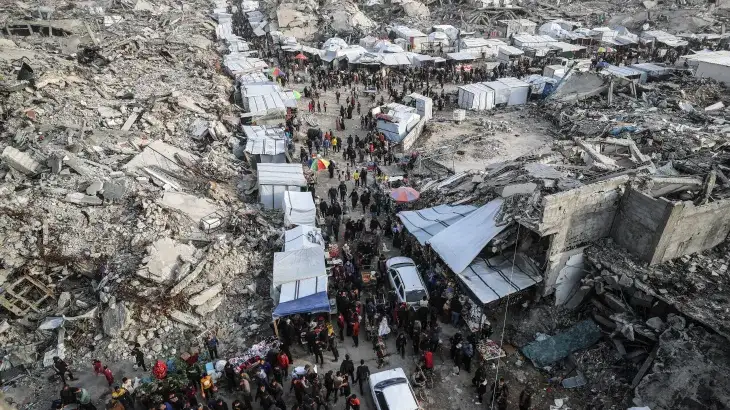20 Killed in Gaza Strikes as Trump Ends Middle East Visit: Ceasefire Hopes Fade
Israeli air raids killed at least 20 people across Gaza on Thursday, just as former U.S. President Donald Trump wrapped up a high-profile visit to the Middle East. Many had hoped Trump’s presence could revive stalled ceasefire talks and push for urgent humanitarian relief. Instead, the region witnessed another surge in violence.

Violence Erupts Despite Hopes for Peace
Israeli airstrikes targeted several locations across Gaza, hitting homes and infrastructure. Palestinian officials confirmed that the dead included women and children. The strikes caused widespread panic and destruction in densely populated areas.
“We had just gone to sleep when everything exploded,” said Amina al-Souri, a resident in central Gaza. “Our home shook, and when I looked outside, the street was filled with smoke, rubble, and people running.”
The Israeli military said it launched the attacks in response to ongoing rocket fire from Gaza-based groups, including Hamas and Islamic Jihad. Officials claimed they struck command posts and weapons storage sites. However, rising civilian casualties have triggered global outrage and humanitarian concerns.
Trump’s Visit Raises — and Then Crushes — Expectations
During his tour, Trump met with Israeli Prime Minister Benjamin Netanyahu and Saudi Crown Prince Mohammed bin Salman. His visit briefly stirred optimism that peace talks might resume or aid would reach Gaza more easily. Trump also made public comments about resolving the conflict.
“The region has suffered too long,” he said in Riyadh. “It’s time to stop the bloodshed and focus on rebuilding lives.”
However, the violence that resumed hours after he left painted a grim picture. Any optimism quickly faded as bombs fell and the death toll climbed.
Gaza’s Humanitarian Crisis Worsens
Gaza’s already dire conditions continue to deteriorate. Hospitals struggle to treat the injured as medicine, electricity, and water supplies dwindle. Displaced families fill overcrowded shelters while food shortages grow more severe.
“We treat dozens of wounded people each day with limited supplies,” said Dr. Nabil Abu Salim at al-Shifa Hospital in Gaza City. “Every airstrike sends more victims through our doors, and we can’t keep up.”
International relief agencies estimate that over 2 million people in Gaza now need immediate aid. However, Israeli restrictions and constant shelling make it nearly impossible for convoys to enter safely.
Global Leaders Respond with Caution
World leaders have issued calls for restraint. UN Secretary-General António Guterres urged both sides to avoid further bloodshed and return to negotiations.
“We must protect civilians at all costs,” he said. “Both sides need to respect international humanitarian law.”
The U.S. State Department voiced concern over the rising casualties and emphasized the need for de-escalation. While reaffirming Israel’s right to defend itself, American officials also stressed the importance of avoiding civilian harm.
European diplomats echoed similar views, urging all parties to commit to dialogue. Meanwhile, protests erupted across several Middle Eastern cities. Demonstrators in Cairo, Amman, and Beirut condemned what they called global inaction and demanded an immediate end to the violence.
Peace Talks Remain Stalled
Despite behind-the-scenes efforts by Egypt and Qatar, ceasefire negotiations remain frozen. Deep mistrust on both sides continues to block progress.
“No one appears willing to compromise,” said regional analyst Layla Haddad. “Trump’s visit attracted attention, but without long-term diplomatic engagement, nothing will change.”
The Israeli-Palestinian conflict has gone through many cycles of violence. Each one erodes hope for a peaceful solution and makes future talks even more difficult. Experts warn that unless both sides and global powers commit to meaningful action, the violence will likely continue.
Gaza Civilians Bear the Brunt
Ordinary Palestinians remain the most affected by the ongoing conflict. Many live without electricity, clean water, or safe shelter. Families face daily trauma, unsure whether they will survive another night.
“My children wake up screaming every time they hear a loud sound,” said Mohammed al-Khatib, a teacher in Rafah. “They ask me if we’ll be alive tomorrow. I don’t know how to answer them.”
Stories like his reflect the grim reality for many in Gaza. As world leaders debate strategy, people on the ground struggle to find food, safety, and hope.
Conclusion: No End in Sight Without Immediate Action
The latest Israeli strikes, which killed 20 people in Gaza, coincided with Donald Trump’s visit to the region. While some hoped his presence might spark diplomatic progress, the attacks underscored how far peace remains out of reach.
newscircuit.inWithout a ceasefire, open humanitarian access, and serious international mediation, the situation in Gaza will only worsen. Symbolic visits and statements won’t stop the suffering. Only bold, consistent action can bring relief to the millions caught in this deadly conflict.
For Gaza’s people, the wait for peace feels endless — and the cost of delay grows with every passing day.






